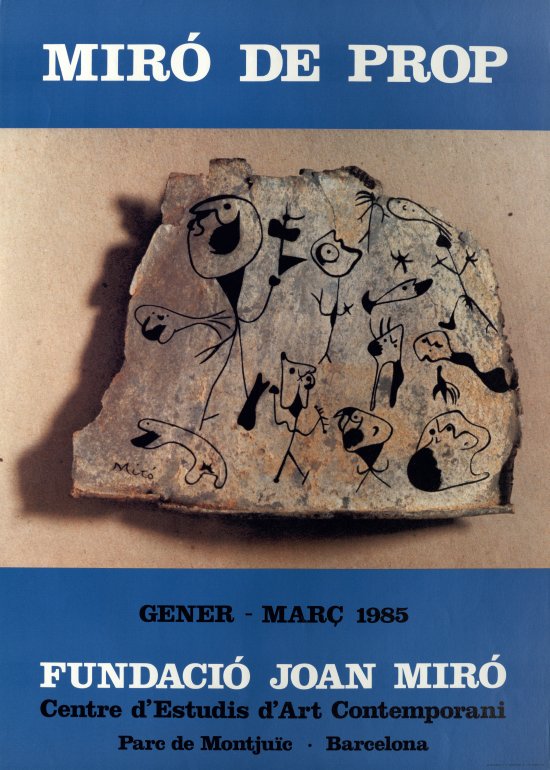- Dates
- —
Miró Up Close
Joan Miró died on Christmas Day 1983. The presence of his work, however, in various parts of Barcelona – his ceramic mural at the airport, his pavement at Pla de l’Os, his monumental sculpture in the park of the old slaughterhouse, his sculpture in the courtyard of the City Council and, above all, the foundation that bears his name – keeps his memory alive.
The Fundació, which was created at Joan Miró’s express wish, not as a static museum where his work could be admired, but as a centre for living art that would house and disseminate the art of our time, did not change its programme when Joan Miró died a year ago, considering the fact that this would have been its founder’s will. But now this institution, which took on the responsibility of devoting itself entirely to the art of our century when it was still not receiving the attention it deserved in Spain, is commemorating Joan Miró with an exhibition that occupies almost the entire Josep Lluís Sert building.
At the time of its creation, the Fundació received a valuable legacy from Joan Miró in the form of its permanent collection: 188 paintings on canvas, paper, wood and other materials created between 1917 and 1978, 145 sculptures; 8 sobreteixims; 2 tapestries; Joan Miró’s complete graphic oeuvre, and almost 5,000 pieces known as the ‘Miró papers’ (academic drawings, sketches, preparatory drawings for paintings, notes and cards).
Almost 300 pieces have been selected from these invaluable holdings for the Miró Up Close exhibition, with the dual purpose of revealing part of the Fundació’s collections and providing the keys to help the public, whether specialist or not, to enter into a dialogue with Miró’s work.
An illustrated, annotated chronology provides additional information on the man and the artist. Explanations accompanying the works underline the importance of each, positioning them in the artistic and historical context in which they were created. Works are therefore presented that go beyond the purely visual, such as the Barcelona series, Joan Miró’s aggressive and austere commentary on the Spanish Civil War, or the triptych The Hope of a Condemned Man, painted when the Franco regime sentenced Salvador Puig Antich to death.
The exhibition also showcases works that have a special significance in the context of Miró’s oeuvre: Painting According to a Collage from 1933, in which Joan Miró tried to overcome the difficulty of organising a harmonious composition of shapes and colours from a collage made up only of black-and-white newspaper cuttings; a series of paintings on a white background from the 1940s; Joan Miró’s first lithographs, made to accompany Tristan Tzara’s book L’arbre des voyageurs; or a self-portrait produced in collaboration with Marcoussis, who taught Joan Miró the drypoint technique.
A real novelty is the presentation of three previously unpublished works, all of them unique although characteristic of Joan Miró’s curiosity for unusual materials in painting or for unusual formats. On the one hand, there are two compositions from 1936, one on fibre cement and the other on a metal cube fragment. The third work that the Fundació is exhibiting in its entirety for the first time is the makimono that Miró produced in 1956. Characteristic of Japanese painting, the makimono is commonly painted in watercolour or gouache, always on a horizontal support, unlike the kakemono, which is always vertical. Both forms were adapted to drawing, engraving and painting at the end of the last century.
In Joan Miró’s ten-metre-long makimono, the strength of the graphic art, importance of the void and delicacy of the medium typical of oriental art are combined together and handled with the personality and unmistakable style of its author.
We are also truly delighted to be able to present in this exhibition Femme, étoile (Woman, Star) from 1933, a virtually unknown work belonging to a private collection.
The richness of the Fundació’s collections now makes it possible, on the first anniversary of the death of its founder, to reveal new aspects of the inexhaustible creative spirit of one of the greatest artists of our century, Joan Miró.
Fundació Joan Miró


